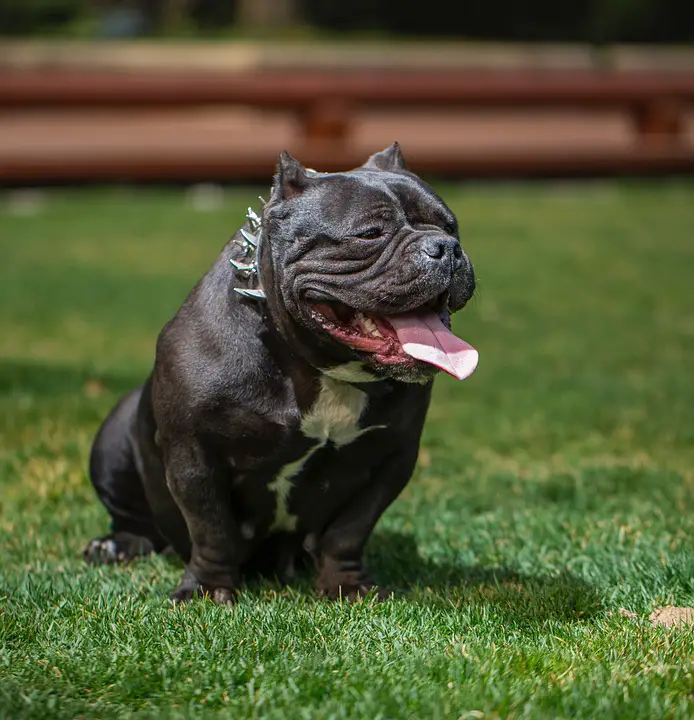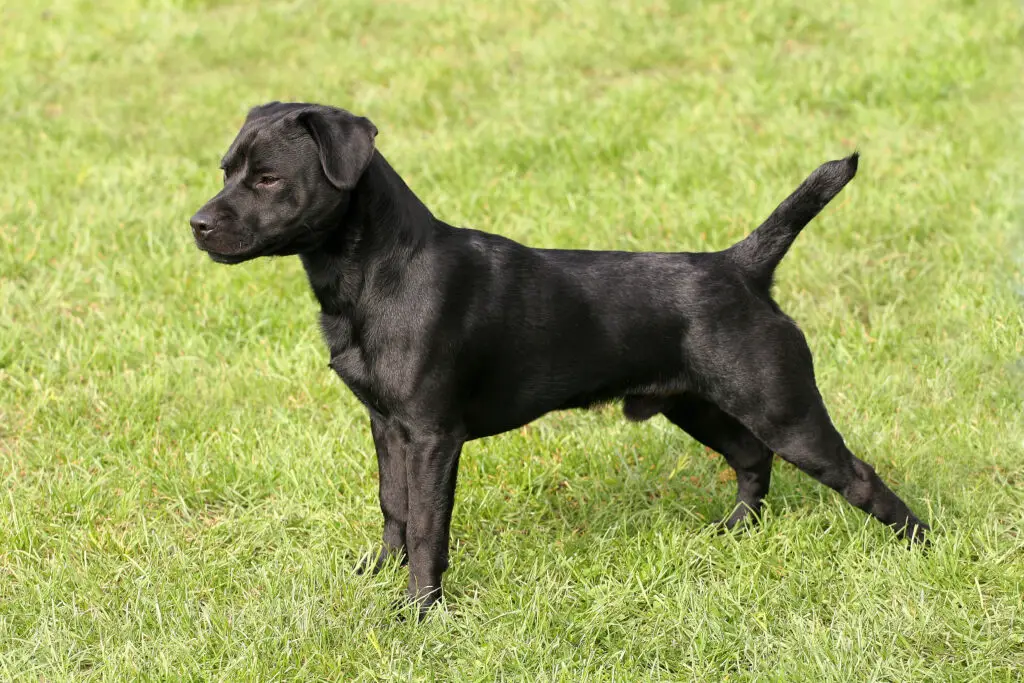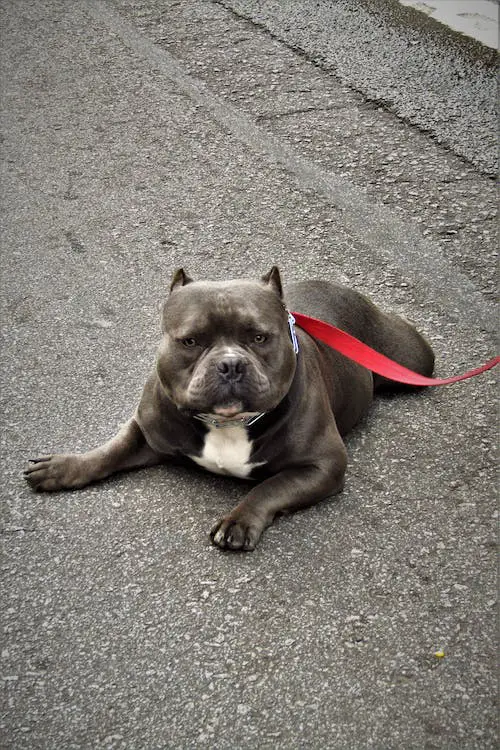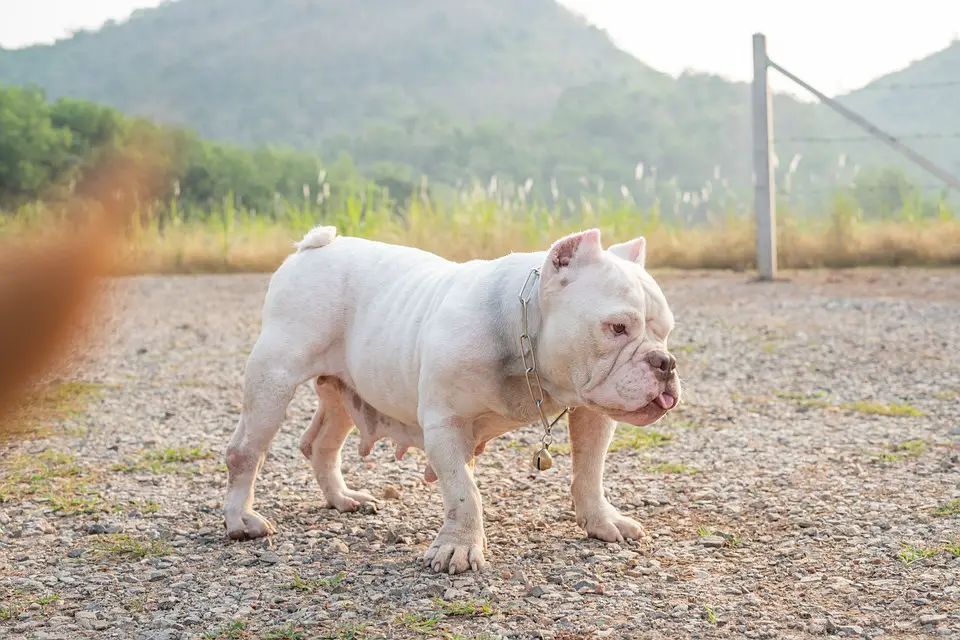Our website is supported by our users. We sometimes earn money when you click an affiliate link and make a purchase. This is at no extra cost to you and helps us to create quality content. Thank you for your support. For all that have shown us such wonderful support, we thank you from the bottom of our hearts!
The Micro Bully is a small and compact designer breed that is known for its muscular body and friendly temperament. This dog is one of the newest dog breeds, having been developed in the United States in the early 2000s.
The Micro Bully is a crossbreed between the Pocket Bully and the Patterdale Terrier, and it has quickly become a popular choice for dog lovers who are looking for a smaller size and manageable dog with a unique appearance and personality.
Also called the Micro Exotic Bully is often lumped in with several different breeds: the Clean Exotic Bully, the Pocket Bully and the Nano Bully.
Micro Bullies will have a body type that is comparable to that of Pocket Bullies, but they will weigh significantly less and only reach a height of about 10 to 14 inches as they mature, in contrast to Pocket Bullies breed standard, which can reach a height of approximately 16 inches as they mature.
The Pocket Bully is a parent breed of the Micro Bully. The Micro Bully is also called a Micro Exotic Bully.
As a designer dog, they are not recognized by the American Kennel Club.
History of the Micro Bully
This new breed was first developed in the early 2000s in the United States. It is a crossbreed between the Pocket Bully and the Patterdale Terrier, two breeds that were chosen for their unique physical characteristics from other bully breeds and good temperament.
The goal of this breeding was to create a smaller and more compact version of the Pocket Bully, with a more muscular build and a friendly personality.
Physical Features of the Micro Bully
Height
This breed is known for its short legs and muscular physique, which gives it a compact and sturdy appearance.

Weight
The Micro Bully is a muscular breed that typically weighs between 10 and 35 pounds. Despite its small size, this breed is strong and powerful, with a broad chest and muscular front legs.
They definitely have the appearance of heavy bone structure with large heads and high set ears, that are usually cropped.
Coat Color
The Micro Bully comes in a variety of colors, including lilac, champagne, piebald, tricolor, merle, black, blue, chocolate, fawn, and brindle. Some dogs may also have white markings on their chest or feet. The coat of the Micro Bully is short and glossy, and it requires minimal grooming.
Coat Type
The Micro Bully has a smooth short coat, with a glossy sheen. This breed does not require a lot of grooming, and its coat is easy to maintain.
Life Span
The Micro Bully has a relatively long life span, with an average life expectancy of between 10 and 13 years. With proper care and attention, this breed can live a long and healthy life.
Temperament & Training of the Micro Bully
Despite its small size, this breed exhibits a confident and fearless temperament. In order to raise a well-behaved and balanced Micro Bully, it is crucial to understand their temperament and provide appropriate training.
Temperament:
The Micro Bully is known for its friendly, outgoing and excellent temperament. This breed is loyal and affectionate, and it loves to be around people, and therefore make great companions. The Micro Bully is also intelligent and easy to train, making it an excellent choice for first-time dog owners.
They are known to be good with children and can coexist peacefully with other pets when properly socialized.
Micro Bullies are highly energetic dogs and require regular exercise to maintain their physical and mental well-being. They enjoy playtime and interactive activities, so it is essential to provide them with sufficient outlets for their energy. Engaging in regular walks, games, and training sessions will help prevent boredom and destructive behavior.
Training:
Training a Micro Bully requires a consistent and firm approach. These dogs are intelligent and eager to please, which makes them highly trainable. Positive reinforcement techniques, such as reward-based training and praise, work best with this breed. Harsh training methods or physical punishment should be avoided as they can lead to fear or aggression.
Basic obedience training should start from a young age. Teaching commands like sit, stay, and come will establish boundaries and enhance the bond between the owner and the dog. Crate training is also recommended to provide the Micro Bully with a safe and comfortable space and to assist in housebreaking.
Socialization is crucial for a Micro Bully. Exposing them to various people, animals, and environments from a young age will help them develop into well-rounded and confident adults. Enrolling them in puppy socialization classes and arranging playdates with other friendly dogs can contribute to their social skills and reduce the likelihood of fear or aggression towards unfamiliar situations.
It is important to establish a consistent routine and set clear rules and boundaries for a Micro Bully. They thrive on structure and need a firm, but loving, leader. Inconsistency or leniency in training can lead to behavioral issues and a lack of respect for the owner’s authority.
Regular mental stimulation is also essential for a Micro Bully. Providing them with puzzle toys, interactive games, and obedience challenges will keep their minds engaged and prevent boredom. These activities will help prevent destructive behavior and promote a well-balanced temperament.
In addition to obedience training, it is important to remember that Micro Bullies need early and ongoing socialization to prevent any potential aggression or fearfulness. Proper socialization helps them become comfortable and confident in different situations, reducing the likelihood of behavior problems as they grow older.
Moderate exercise is best with around 20-30 minutes per day. With their shorter snouts, they are considered to be brachycephalic. Which means that they have trouble breathing in general and can be prone to overheating with too much exercise and warm temperatures.
In conclusion, the Micro Bully is a breed with a confident and friendly temperament. With the right training and socialization, they can make excellent family pets.
Consistency, positive reinforcement, and early socialization are key to raising a well-behaved and balanced Micro Bully. By providing them with the necessary physical and mental stimulation, owners can ensure a happy and fulfilling life for their Micro Bully companion.
See our mention in MIC.com! Trainers say you can get your dog to act a hell of a lot better with any of these genius tricks.
Health Issues of the Micro Bully
As a crossbreed, the Micro Bully may inherit some health issues from its parent breeds. Here are some common health issues that both the Pocket Bully and the Patterdale Terrier may experience:
Parent Breed 1: Pocket Bully which is a mix of the American Pit Bull Terrier and the American Staffordshire Terrier.
Because Pocket Bullies are a hybrid, it is possible that it will acquire certain health problems from both of its parent breeds. The following is a list of some of the most prevalent health problems that can affect both the American Pit Bull Terrier and the American Staffordshire Terrier:
Parent Breed #1a: American Pit Bull Terrier
• Hip dysplasia is a genetic problem in which the hip joint does not grow properly, which can result in arthritis as well as pain. This issue can be passed down from parent to child.
• Allergies: Some Pit Bulls may be predisposed to developing allergies, which can lead to itching and irritation of the skin.
• Cardiovascular disease: Some Pit Bulls are predisposed to developing cardiovascular illness, which can eventually result in heart failure.
Parent Breed #1b: Staffordshire Terrier

The other parent breed of the Pocket Bully is the American Staffordshire Terrier and their common health issues are:
• Hip dysplasia again, this is a genetic problem in which the hip joint does not grow properly, which can result in arthritis as well as pain.
• Allergies to the skin: Some Staffordshire Terriers may be predisposed to developing skin allergies, which can lead to uncomfortable itching and other symptoms.
• Thyroid issues: Some Staffordshire Terriers are predisposed to developing hypothyroidism, which can result in weight gain and lethargic behavior in the dog.
- Parent Breed 2: Patterdale Terrier

Patellar luxation: This is a condition where the kneecap slides out of place, which can cause pain and lameness. This can lead to discomfort, lameness, and difficulty in walking. Regular exercise, a balanced diet, and maintaining a healthy weight can help prevent this condition.
Eye problems: Some Patterdale Terriers may be prone to eye problems, such as cataracts and glaucoma.
Another eye issue to watch out for is progressive retinal atrophy (PRA), an inherited eye disorder that causes gradual vision loss and can eventually lead to blindness. We’ve talked a lot about this in other articles but here is a recap:
Progressive Retinal Atrophy (PRA)
Dogs of all breeds, can be affected by a series of inherited eye illnesses known as progressive retinal atrophy (PRA). These diseases affect the retina. The degeneration of the retina that PRA causes ultimately results in total blindness. However, vision loss can occur at any stage of the disease.
PRA is an inherited disorder that can present in Micro Pocket Bully as early as 2-3 years of age. Some of the symptoms of PRA in Maltese dogs include night blindness, dilated pupils, and a loss in visual acuity. Dogs that are affected by the sickness may go fully blind as the condition worsens.
Owners can work with their veterinarians to establish a treatment plan for their dogs that may involve environmental adaptations, such as keeping the house free of obstructions and using auditory cues to help lead the dog.
Additionally, owners can provide additional support and training to assist their dogs in adjusting to their blindness.
Regular eye check-ups and genetic testing before breeding can help identify carriers and reduce the risk of passing on this condition to future generations.
Dental issues: Some Patterdale Terriers may develop dental issues.
Unfortunately, Small breed dogs are more susceptible to dental issues such as tooth decay, gum disease, and tartar buildup.
It is more difficult to clean the teeth of a small dog because their mouths are so small that there are more hard to reach areas. Regular dental care, including brushing their teeth, providing dental chews, and scheduling professional cleanings, can help maintain good oral health.
Patterdale Terriers are also prone to allergies, which can manifest as skin irritations, itching, and hair loss. Allergies can be triggered by various factors such as food, environmental allergens (pollen, dust mites), or contact with certain substances. Identifying and eliminating the allergen, if possible, and providing proper veterinary care can help manage this issue.
Hip dysplasia, a genetic condition where the hip joint doesn’t develop properly, can affect Patterdale Terriers as well. This can cause pain, lameness, and difficulty in moving. Responsible breeding practices, such as screening breeding dogs for hip dysplasia, can help reduce the incidence of this condition.
Additionally, Patterdale Terriers may be prone to certain types of cancers, including mast cell tumors and bladder cancer. Routine veterinary check-ups, early detection, and prompt treatment are essential in managing these conditions.
Regular exercise, a balanced diet, and maintaining a healthy weight are crucial for the overall health and well-being of Patterdale Terriers. Providing them with a stimulating environment, mental enrichment, and socialization can also contribute to their overall happiness and reduce the risk of behavioral issues.
Because of crossbreeding, it betters the chances that your dog will not inherit these traits, but being aware of all of the possibilities can make it so you can catch any new behaviors and match them with possible illnesses.
That said, though there is no health guarantee, exercise, a good diet and regular vet visits can help to keep your dog healthier.
Grooming Your Micro Bully

Grooming plays a vital role in maintaining the health and appearance of a Micro Bully. While they have a short and low-maintenance coat, there are still important grooming tasks to consider:
Brushing: The Micro Bully’s coat is relatively short and requires minimal brushing. However, a weekly brushing with a soft-bristled brush like this Double Sided Combo Pins and Bristle Brush by Hertzko can help remove loose hair and distribute natural oils, keeping their coat shiny and healthy. This brushing session also serves as an opportunity to check for any skin issues or abnormalities.
Bathing: The Micro Bully is not prone to excessive oiliness or odor, so frequent baths are not necessary. However, if they get dirty or smelly, a bath using a mild dog shampoo can help keep them clean and fresh. It is important to avoid over-bathing, as it can strip the coat of its natural oils and lead to dry skin.
Cutting Fur/Hair: The Micro Bully’s coat does not require any specific haircuts. However, some owners may choose to trim the hair around the ears or paws for a neater appearance. It is important to use appropriate grooming tools and exercise caution while trimming to avoid accidentally injuring the dog.
Clipping or Grinding Nails: Regular nail maintenance is essential for the Micro Bully’s comfort and overall health. Long nails can cause discomfort and may even affect their gait. Using nail clippers or a nail grinder, the nails should be trimmed regularly, ensuring not to cut too close to the quick. If the owner is unsure or uncomfortable with this task, a professional groomer or veterinarian can assist.
But first, check out our article on How to Grind Your Dog’s Nails Safely.
To find the best grinder for your dog, check out this article on choosing a grinder.
Dental Care: Dental hygiene is crucial for the Micro Bully’s oral health. Regular teeth brushing helps prevent plaque buildup, gum disease, and bad breath. A dog-specific toothbrush and toothpaste should be used, as human products can be harmful to dogs. Establishing a routine of brushing their teeth several times a week is recommended.
Cleaning Ears: The Micro Bully’s ears should be checked regularly for signs of infection, excess wax buildup, or irritation. Using a cotton ball and a gentle ear cleaner recommended by a veterinarian, the outer part of the ears can be cleaned. It is important not to insert anything into the ear canal, as this can cause injury. If there are any concerns or abnormalities, consulting a veterinarian is advised.
Or, you can use these convenient ear wipes. These are compact and good for travel.
By following these grooming practices, owners can ensure that their Micro Bully maintains a healthy coat, clean teeth, and overall well-being. Regular grooming sessions also provide an opportunity for owners to bond with their dog and monitor their physical condition.
Owning a Micro Bully

Special Traits
The Micro Bully is a unique breed with several special traits that make it a popular choice for dog
lovers. Here are some of the special traits of the Micro Bully:
- Compact size: The Micro Bully is a small and compact breed that is easy to manage in smaller homes or apartments.
- Muscular build: Despite its small size, the Micro Bully is a muscular breed that is strong and powerful.
- Friendly temperament: The Micro Bully is known for its friendly and outgoing temperament, and they make great family dogs.
- Easy to train: The Micro Bully is intelligent and easy to train, making it an excellent choice for first-time dog owners.
- Cost of Purchase
The cost of a Micro Bully can vary depending on several factors, including the breeder, location, and pedigree. On average, a healthy Micro Bully from a reputable breeder is very expensive. And if we have said it once, we will say it again…it is VERY important to do your research and find a reputable breeder who is breeding healthy and well-socialized dogs.
The average cost of a Micro Bully can be as much as $10,000 for a high quality dog.
Maintenance Costs

In addition to the initial cost of purchasing a Micro Bully, there are also maintenance costs to consider. Here are some of the maintenance costs associated with owning a Micro Bully:
- Special training: If you plan to train your Micro Bully for specific tasks or activities, such as obedience training or agility training, there may be additional costs associated with specialized training classes or equipment.
- Medical costs: Like all dogs, the Micro Bully may require regular veterinary care, including vaccinations, check-ups, and preventative care. In addition, if your dog develops any health issues, there may be additional costs associated with treatment and medication.
- Grooming costs: While the Micro Bully does not require a lot of grooming, there may still be some grooming costs associated with regular brushing, bathing, and nail trimming.
- Food and supplies: Like most dog, the Micro Bully will require a regular supply of food, treats, and toys, which can add up over time.
Finding Breeders
When looking for a breeder to purchase a Micro Bully from, it is important to do your research and find a reputable breeder who is breeding healthy and well-socialized dogs. Here are some tips for finding a reputable breeder:
- Research: Look for breeders who have a good reputation and positive reviews from past customers. You can also check with breed-specific organizations or clubs for recommendations.
- Visit the breeder: It is important to visit the breeder in person to see the conditions in which the dogs are kept and to meet the puppies and their parents. This will give you a good idea of the breeder’s practices and the temperament of the dogs.
- Ask questions: Don’t be afraid to ask the breeder questions about their breeding practices, the health of their dogs, and their socialization and training methods.
- Health testing: Look for breeders who health test their dogs for genetic health issues and can provide documentation of the results.
Drawbacks of Owning
While the Micro Bully is a popular and beloved breed, there are also some drawbacks to owning one. Here are some potential drawbacks to consider:
- Health issues: As a crossbreed, the Micro Bully may be prone to some of the health issues of its parent breeds. It is important to be aware of these potential health issues and to provide your dog with regular veterinary care.
- Exercise needs: While the Micro Bully is a small breed, it still requires regular exercise and activity to stay healthy and happy. You need the correct amount so that your brachycephalic dog doesn’t overheat.
If you are not able to provide your dog with enough exercise and stimulation, they may become bored and destructive. - Breed-specific legislation: Some areas have breed-specific legislation that prohibits or restricts the ownership of certain breeds, including Pit Bulls and Staffordshire Terriers. It is important to check local laws and regulations before purchasing a Micro Bully.
- Ear cropping: is commonplace but not required (or recommended). There are some micro bullies that haven’t had their ears cropped and they look like a french bulldog. One good thing is that it is not commonplace crop their natural, medium length tails into short tails.
The Bottom Line on the Micro Bully
The Micro Bully is a unique and beloved breed that has become increasingly popular in recent years. With its compact size, muscular build, and friendly temperament, it is a popular choice for families and dog lovers.
However, it is important to be aware of the potential health issues and maintenance costs associated with owning a Micro Bully, as well as any breed-specific legislation in your area.
If you are a home owner, you may want to check your insurance to make sure that there are no penalties for owning a Micro Bully.
With proper care and attention, the Micro Bully can make a wonderful and loyal companion for many years to come.
Please read our Legal Disclaimer

